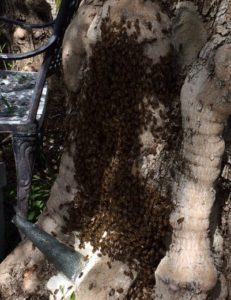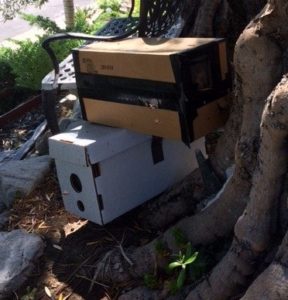Hello Fellow Readers,
We had a near-stinging episode from a garden pot begging for its annual dressing, a task not yet done due to a humbling hand procedure gratefully on the mends. A client grew tired of deer spraying and passed along Hosta, which I nested in the pots as a temporary measure. When Curt was helping to dig them in, a slew of yellow jackets emerged. “Run,” he yelled, and we did. Thankfully, avoiding their sting. Curt’s experience with the stealth aggression of yellowjackets now qualifies him for an EpiPen. “They’re dirty bees,” the doctor explained when, in truth, yellowjackets are predatory wasps that feed primarily on insects, including garden pests. But their garden benefits turn dangerous if their nests are disturbed, often hidden underground.
Yellowjackets versus Honeybees
At first glance, yellowjackets and honeybees look similar. However, yellowjackets have distinctive yellow and black bands, while honeybees sport brown and yellow. Plus, honey bees are hairy and readily collect and disperse pollen as they go from flower to flower. Yellowjackets are hairless. Please don’t hold that against them, though. So is Curt. (Sorry, dear, I couldn’t resist.) They can still serve a pollinating role when hunting insects or seeking sugar from nectar in late summer, preparing for next year’s queen.

Linda’s honeybees were too deep in the tree to reach for removal and “acted oddly,” requiring seven visits over four months to relocate!
In February, my lifelong friend Linda in Mission Viejo, California, shared honeybees are inundating their sixty-year-old olive tree. I remember during a visit convincing her the tree, though technically too close to the front door, should remain. The tree has such character, with multiple gnarly trunks bursting into a dense green canopy, offering a shady seating spot below. Now, with all the bee activity, there’s no sitting under the tree. More problematic is their dog Sugar had a near-death experience when she was stung.
How Bee Location Companies Work
In the spirit of saving the crucial pollinators rather than extinguishing them with pesticides, Linda sought out a bee relocation company. They closed the tree openings and installed a metal mesh cone that allowed the bees to exit the hive but not re-enter. Pheromones enticed the estimated swarm of 20,000 bees to enter a temporary box hive below the tree.
I checked in on Linda to learn the bee status. Four months later, they are still there. The first box of pheromones didn’t attract them, and it turns out Linda’s honeybees “acted oddly,” according to Dan, the bee man of We Save Bees, who never saw anything like it. After seven visits to seal up entries, the bees managed to find a way into their hive by digging in the ground each time. Linda described the bubble of bees working and the “bee pile of the lazy buggers who opted out of the dig.” It turns out theirs was a subterranean hive in the underground caverns around the roots. At last, it seems they’ve managed to plug up all the entries.
A happy ending for the honeybees
There are now an estimated 50,000 honeybees in the box hive, ready to be relocated to Temecula, CA, where they will work on a farm. “I have enjoyed my bee experience and will miss the little guys,” wrote Linda, who added, “Were it not for Sugar, I would have set up a hive and officially become a beekeeper!”
Garden Dilemmas? Askmarystone@gmail.com and your favorite Podcast App.
Spring 2024 There’s an update to the story in Relocating Honeybees – Being Kind, also featured in the Garden Dilemmas Podcast:

Smoke from native wood is used to calm the bees. A temporary Box Hive with pheromones was set below the tree to entice the bees to enter.

Openings were filled with insulation and sealed with plaster. The cone installed allows bees to exit but not re-enter. They’ll permanently seal the openings once all the bees have vacated the tree.

Once no stragglers are left behind, they’ll move the temporary Box Hive with about 50,000 honeybees. Thank you, Linda, for sharing the story and saving the bees!
Need to relocate a honeybee hive? Your local Beekeepers Association can guide you in finding bee relocating providers, many of whom are beekeepers themselves. Many don’t charge for their service. However, they advise after the bee removal, there are often repairs the homeowner will have to make.
Link to Beekeeping Associations In North America
Click through to learn more about how we can do our part to help our pollinators—How can it Be?


